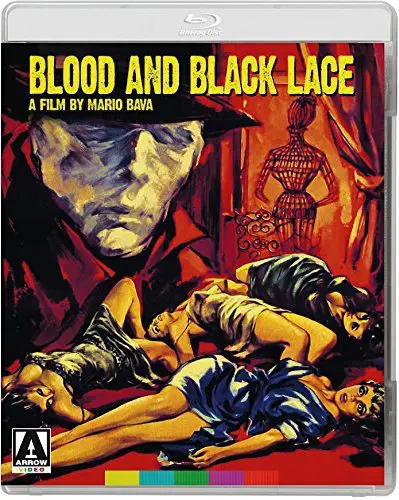
Blood and Black Lace, a lurid proto-slasher movie with gruesome and copious violence, is one of the most visually beautiful movies ever made. Bathing his shots in ostentatious colors with little concern for sourcing the light, Mario Bava’s seminal Giallo film has only a glancing connection to realism (Giallo being the particularly Italian style of murder mystery, de-emphasizing the investigation and focusing on the murders themselves.) It’s more like a fever dream, too sensuous to be a nightmare but too bloody and malign to be a pleasant fantasy. It’s one hell of a movie.
The story is hardly the point with a film like this, but it exists to provide motivation for the various stylish scenes Bava stages. At a fashion house, a woman is murdered by a masked man. The subsequent investigation reveals that most of the models and designers working at the fashion house have secrets they don’t want the police to uncover, and in trying to keep their secrets they make themselves further targets for the masked man.
All of the characters in Blood and Black Lace are less developed than quickly sketched – there’s the guy with the drug habit, the creepy antiques dealer who’s dating multiple models at once, the count, the owner of the fashion house and her lover. They all exist more or less to be victims or suspects, and don’t have much more to say or do than the ubiquitous mannequins strewn about the fashion house – they just move more, but serve the same purpose of filling up Bava’s screen with sumptuous images.
None of these observations are complaints. The film never establishes a main character because the point is to be carried away with the visuals. Were this a pedestrian looking film, it would be a complete bore. Instead, it is a marvel of style. An ever-roving camera moves through exquisitely lit scenes, the quality of the images all the more amazing considering the film’s small budget (on an extensive interview from the 80s available on this disc as an extra, star Cameron Mitchell reveals that Bava’s “dolly” was a kid’s wagon, holding the camera, that he’d push around.) While the camera often acts as a POV, moving through scenes, it is often explicitly not the point of view of any character. It’s the director’s, taking the audience by the hand and showing them what he wants them to see.
As a precursor to the modern slasher movie, it is the murders in Blood and Black Lace that get most of the director’s attention. Each one is staged and lit in a completely different location, giving the director new places for the masked man to leap out from, and new places for his victim to cower. The first murder is intimate and brutal, taking place on a shadowy wooded path in the dark. The next is in the antique dealer’s shop, where creepy purple lights bath the victim’s face, and bra: since eroticism is intermingled with violence in Giallo movies, nearly every murder involves the woman eventually at some level of undress. The victims are exclusively women, and the lack of characterization, the detachment of the narrative from any single character creates a sense of complicity for the viewer. You’re not all that interested in the woman getting away from the killer – you just want to see what he’s going to do to her. For those who like to find misogyny in anything containing violence against women, this movie will provide plenty of fodder for you.
Whether it’s anti-social, anti-woman, or just abhorrent, Blood and Black Lace is gleefully, defiantly what it is: a movie about watching gorgeously staged murders. It does not make a larger social statement, or attempt (at least on the surface) to be anything but a gruesome and gruesomely beautiful entertainment, and on that level it succeeds gloriously.
Arrow Video’s release of Blood and Black Lace is sourced from a new restoration of the film, scanned in at 2k. The video is pristine, the colors gorgeous. It contains Italian and English soundtracks, and copious extras: three documentaries (an hour-long discussion of Giallo and Bava in general with several Italian commenters including Dario Argento and Baba’s son Lamberto, a short discussion by the filmmakers of some neo-Giallos, and a cultural-historical visual essay), a commentary track by Bava-expert Tim Lucas, a short neo-noir film titled Yellow, and a 12-minute panel discussion with Dario Argento, Lamberto Bava and Steve Della Casa. My favorite of the extras is a pair of episodes of The Sinister Image, a public access TV show from the ’80s hosted by horror enthusiast David Del Valle. These two episodes are each half-hour interviews with Cameron Mitchell, veteran of hundreds of B-movies, who is a genial interview, and gushes about working with Bava, who directed him six times.